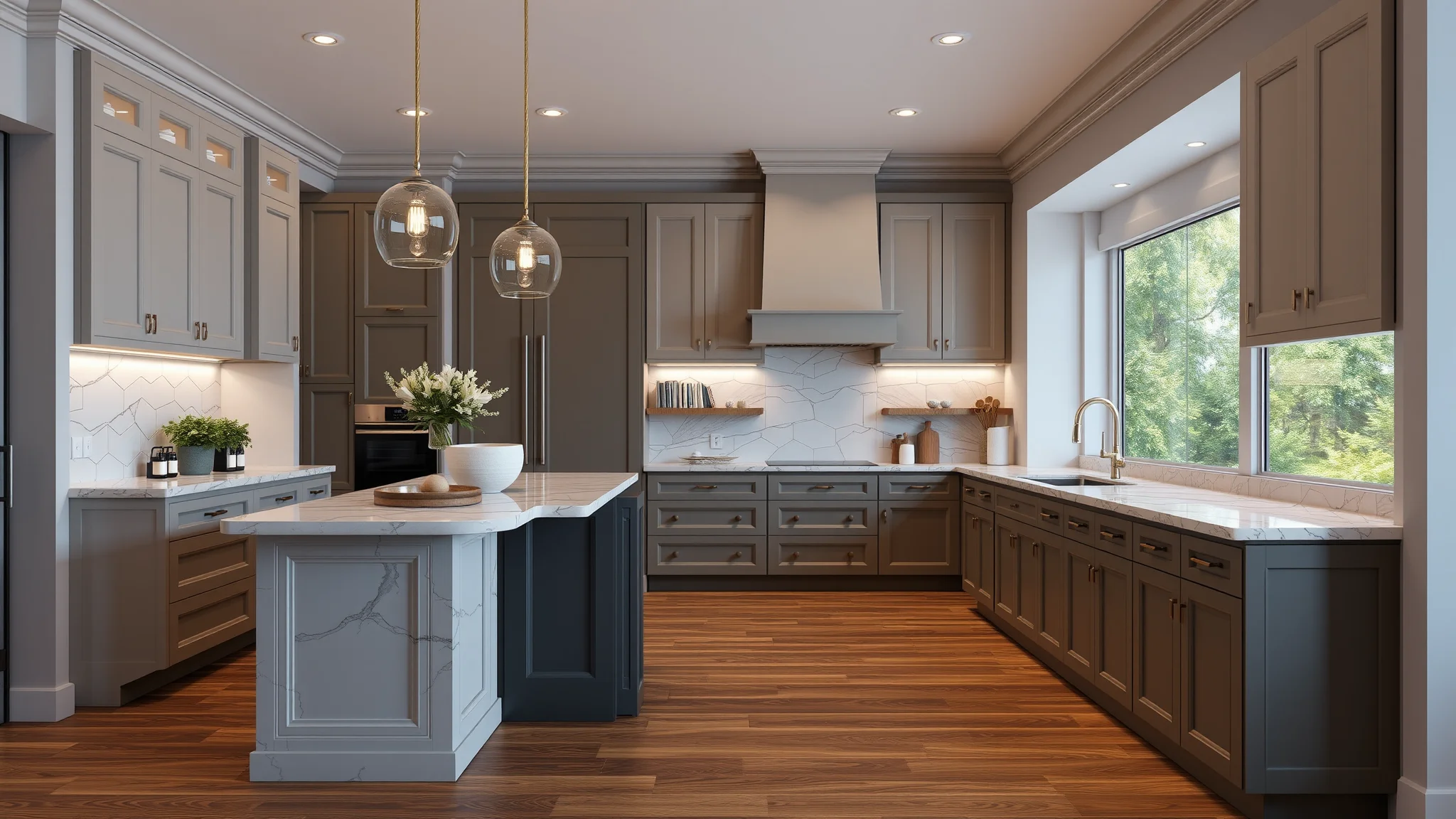
Tips for Organizing a Cluttered Kitchen: Expert Storage Solutions
How Can You Effectively Declutter Your Kitchen Space?
Creating an organized kitchen doesn't happen overnight, but with strategic steps, you can turn chaos into calm. Start by assessing your current setup—identify the items that are used daily versus those that are rarely touched. This initial audit helps in understanding what to keep, donate, or discard. Remember, an effective decluttering process is about making room for what matters most and reducing visual and physical clutter that hampers efficiency.
One practical approach is to categorize your kitchen items into zones: cooking, baking, cleaning, and food storage. Assign specific spaces for each category. This zoning technique simplifies decision-making and keeps everything within reach. For example, frequently used utensils should be stored near the prep area, while seldom-used gadgets can find a home in upper cabinets or storage closets.
What Are Proven Strategies for Maximizing Kitchen Storage?
Enhancing your kitchen's storage capacity is key to maintaining a clutter-free environment. Consider investing in customizable shelving units that adapt to your unique needs. Incorporate kitchen cabinets 600mm wide to optimize space both horizontally and vertically, allowing you to neatly organize everything from dishes to pantry staples.
Utilize vertical space by installing wall-mounted racks, magnetic strips for knives, or hanging pot racks. Additionally, drawer organizers and pull-out trays can dramatically improve accessibility to small items and minimize misplacement. Don’t forget to take advantage of corner spaces with lazy Susans or corner drawers—these clever solutions turn dead zones into functional storage.
How Can You Use Labels and Clear Containers to Simplify Kitchen Organization?
Labels and transparent containers are invaluable tools in the quest for an organized kitchen. Using clear jars for dry goods such as flour, sugar, and pasta allows for instant visibility. Labels ensure everyone in the household knows exactly where to find and return items, reducing clutter caused by misplaced goods.
Moreover, grouping similar items together—like spices, baking supplies, or snack foods—makes it easier to locate what you need without rummaging through cluttered cabinets. Regularly reviewing and reorganizing your containers helps maintain order over time. For a seamless aesthetic, coordinate your storage containers to match your kitchen's design theme, contributing to a harmonious look.
What Are Common Mistakes to Avoid When Organizing a Cluttered Kitchen?
Many homeowners overlook certain pitfalls that undermine their organizational efforts. For instance, stacking too many items in one space can lead to instability and frustration. Avoid overfilling cabinets or cluttering countertops, which can impair workflow and safety.
Additionally, neglecting to purge unused or expired items results in wasted space and clutter buildup. Implementing a regular decluttering schedule—perhaps monthly—ensures your kitchen remains streamlined and functional. Resist the temptation to keep duplicates of utensils or appliances that serve the same purpose, as they contribute to unnecessary clutter.
How Do You Create a Functional Workflow in Your Kitchen?
An organized kitchen is also a well-designed one in terms of workflow. Think about the natural sequence of meal preparation—gathering ingredients, prepping, cooking, plating, and cleaning. Position related items along this sequence for maximum efficiency.
For example, store cutting boards and knives near the prep zone and dishware near the sink and dishwasher. This logical placement minimizes unnecessary movement and saves time. Consider establishing designated zones for each activity, such as a baking station with measuring cups, mixers, and baking sheets grouped together. This setup not only enhances efficiency but also reduces clutter by assigning specific locations for each tool.
How Can You Maintain an Organized Kitchen in the Long Term?
Initial organization is only part of the solution; maintaining it requires discipline and routine. Develop habits such as putting things back in their designated places immediately after use. Periodically reassess your storage solutions—what once worked might need adjusting as your needs evolve.
Make cleaning and organizing part of your weekly routine. A quick tidying session helps prevent clutter from accumulating again. Additionally, consider upgrading your kitchen elements—such as energy-efficient appliances—which can streamline your tasks and make maintaining order easier. For insights on optimizing your home’s energy efficiency, explore making bathrooms more energy efficient.
What Are Innovative Storage Solutions to Consider?
Thinking outside the box with storage can revolutionize your kitchen organization. Consider installing pull-out pantry shelves that allow easy access to items in the back. Remember that vertical space isn’t just for shelving; hanging racks for pots and pans free up cabinet space and add a charming industrial look.
Magnetic spice jars, under-cabinet knife holders, and fold-away tables or counters are also innovative solutions that maximize functionality without crowding your space. Prioritizing these ideas helps create a kitchen that is not only organized but also visually appealing and welcoming.
How Do You Organize Your Kitchen During a Renovation?
If your current kitchen layout is limiting your organizational efforts, a renovation might be the ideal solution. Working with a professional contractor ensures your space is optimized for both style and function.
Consider engaging experts for home remodeling advice that extends to your kitchen. They can help design custom storage solutions tailored to your needs, such as built-in spice racks, spacious drawers, and smart lighting. A thoughtful remodel transforms a cluttered space into a sleek, efficient kitchen where organization feels intuitive.
What Are the Best Practices for Maintaining a Clutter-Free Kitchen During Busy Weeks?
Busy schedules can easily derail your organizational efforts. The key is to implement simple, sustainable practices that keep clutter at bay. For instance, designate a specific time each day to tidy up—perhaps at the end of your cooking session or before bed.
Create daily routines, such as wiping down counters, decluttering the table, and ensuring dishes are washed promptly. Incorporate storage solutions that encourage quick clean-up, like dropdown baskets for utensils or quick-access drawer organizers. With consistent effort, you can enjoy an organized kitchen even during hectic weeks.
Frequently Asked Questions (FAQs)
Start with DIY solutions like repurposing containers, using old jars for storage, and decluttering proactively. Simple adjustments such as installing affordable shelf organizers or utilizing existing cabinet space effectively can make a significant difference without high costs.
Utilize vertical storage, invest in multi-functional furniture, and keep countertops clear. Installing wall-mounted racks and using door organizers help make the most of limited room, creating a more open and accessible environment.
Implement designated zones for different activities, label storage containers clearly, and keep frequently used items within arm’s reach. Regularly reassessing your setup ensures it adapts to your changing needs, maintaining efficiency for all family members.
Develop consistent habits like regular decluttering, cleaning, and re-evaluating storage arrangements. Educating all household members on organizational systems helps sustain order over time.
Ready to elevate your kitchen into a masterful space of both beauty and function? For expert guidance on remodeling and optimizing your home, explore the comprehensive home remodeling blogs offered by Premier Home Builders of Florida. Our team is committed to bringing your vision to life with durability, style, and efficiency.




















